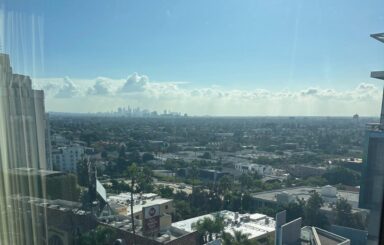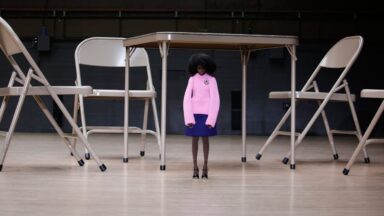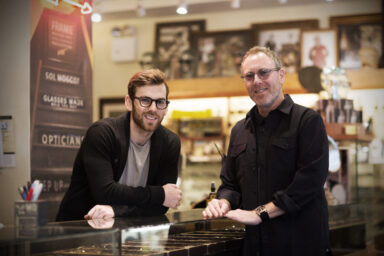In light of the opening of her latest exhibition, running at Paris’ Galerie Sophie Scheidecker March 19—April 30, the photographer sheds light on how COVID-19 made her come full circle with the early days of her artistic production

An image from the series, New York City Lockdown by Stephanie Pfriender Stylander
Text by: Gilda Bruno
“There’s something that I find so incredibly interesting about photography,” says Stephanie Pfriender Stylander while discussing her new exhibition, New York City Lockdown, on a casual Zoom call with Collectible DRY. “The fact that it truly lives on as if it had multiple lives, it never just goes away.”
Launching today at the Galerie Sophie Scheidecker in Paris, the photographer’s latest showcase is a poignant black-and-white documentation of how the coronavirus outbreak disrupted the regular course of things by urging everyone to “press pause” on their life.
On display until April 30, the exhibition will also allow virtual visitors in thanks to a digital tour of the gallery interiors, made available to everyone by contemporary art platform Artland.
Mostly known for her thought-provoking fashion photography and celebrity portraiture, in this series Stephanie Pfriender Stylander went back to the roots of her love for photography to fully capture the melancholic, almost fragile atmosphere of a New York deprived of its tireless dynamicity.
“I was always more interested in photography as an art form, as a means of communicating a mood, a feeling, or an idea,” explains the photographer who, below, retraces the evolution of her artistic path.

An image from the series, New York City Lockdown by Stephanie Pfriender Stylander
Collectible DRY: Could you tell us anything about the early days of your career as a photographer?
Stephanie Pfriender Stylander: I went to the School of Visual Arts in New York City. When I was a student there, I would just go to the phone booth down the street and put in my quarters before getting on the train back to New Jersey, where I was living with my parents. I had a list with the names of all the great photographers I wanted to get in contact with and one of those names was Art Kane. One day, he just happened to answer the phone. We had an instant connection, so he said to me, “Okay, come in, I’ll meet you.” Assisting Art Kane gave me a close-up view of how he put together shoots and the concepts behind them. Plus, he would let me edit with him the photographs, and we would talk a lot about why one picture worked better than the next.
After that, I spent a few years in New York. I would use my mother’s credit card to get fashion from the clothing stores, and then return the clothes. I would always find some way to get in, which helped me a lot in the beginning. In the late ’80s, I was commissioned some casual fashion jobs, not editorial ones, but fully advertising. At that time, it was very popular for an American to move to Europe. People would say, “If you go to Milan, you’ll come back with 50 tear sheets within six months.” I knew a person that had an apartment there who said I could stay with her. So I moved to Milan and that initial period turned into about three years because, obviously, it took me much longer to start getting work.
Back then, I used to make money by arranging model tests with modelling agencies. I was just mastering the craft, so to say. After several years of doing that, I finally got a break: an editor hired me to do a story for Max Magazine and, after it got published, I got noticed from Harper’s Bazaar, Elle, and all these different magazines. The editors took a liking to the image that separated me from a lot of other photographers, which was a bit more gritty towards and had more of a cinematic, edgy character-driven feeling, rather than being too sophisticated. After one year of intense work in Milan, I relocated to Paris, where I was convinced to work with actors, which I absolutely loved. I then decided to go back to New York. Most of my work was on location, so I travelled a lot. I was basically jumping from an aeroplane onto the next, which is something that I miss about those years.

An image from the series, New York City Lockdown by Stephanie Pfriender Stylander
CD: The good old times when everything was possible.
SPS: Right, it was very stressful, but also incredibly exciting.
CD: What sort of function has photography taken on amid the ongoing pandemic and how is that exemplified in your latest exhibition, New York City Lockdown?
SPS: I think it’s a gift to be a photographer during this time, as it enables you to live such a catastrophic historical event up-close and personally. You can really dive in and create your own reportage of it. When I started working on New York City Lockdown, I recollected the times when I was living in Paris: back then, I would go up to foggy Montmatre in the morning, when I knew that not a lot of people would be around, to photograph everything that captured my attention with my Leica, just like I did in this series.
As I walked in the empty neighbourhoods of New York, those old photographs of mine revealed themselves and spoke to me. It was just like revisiting an old letter I hadn’t read for years, or running into a lover I hadn’t seen in ages: so many memories were evoked by what I went through during the pandemic. I was finally able to feel and see things that I would have normally walked by and ignored, caught up as I was by the many distractions of this huge city. Photography is probably one of the most beautiful forms of art one can use to document times like these.

An image from the series, New York City Lockdown by Stephanie Pfriender Stylander
CD: You were always more drawn to the photographic medium as “an art form and a means of communicating a mood, a feeling, and an idea” than you were to the world of fashion and entertainment photography. How have you incorporated this personal inclination into the “glamourous” editorials you’ve produced over the years?
SPS: I never kept moving along those lines, but rather shifted into thinking, “This is what my work is, this is what I’m known for, and this is why I’m a photographer.” You have years where your picture isn’t relevant, but that’s exactly when you have to hone your craft and stay real to yourself by all means necessary. There’s always going to be times when you’ll have to do work that doesn’t really fit your parameters, yet that’s still part of the game. Sooner or later, you get to a stage in your career where you have a code that signals your work to somebody else’s work and, of course, you want to follow that code as much as you can.
In this sense, New York City Lockdown really harkens back to the early days of doing those poetic, captivating, and ambiguous fashion stories. “Ambiguous” is probably the most fitting term to describe the work that I’m the closest to. There’s always an underlying ambiguity in my photographs, as the viewers play a crucial role in deciding upon what they want to see. So my own work becomes, to some extent, a reflection of the viewer’s own imagination. Because of its many plays of transparencies, shadows, and lights as well as to the not-knowing exactly what you’re looking at, this showcase can be seen as part of a continuum of the photography work that made me stand out from the crowd at the beginning of my career.
CD: If you were to pick one character out of the incredible personalities you’ve portrayed over the years, who would that be?
SPS: I’m just going to say the first name that came to my mind, which is Joaquin Phoenix. He’s such an unbelievably superb actor, but he’s also got very unusual energy in person. Whenever you get the chance to meet those major stars, it’s always a little awkward at first: there is this kind of wall that you need to slowly try to dissolve. What happened with him on that occasion was truly magical. By the end of the shoot, he was on the floor of the studio where we were shooting, and I was as well; we just found ourselves playing as two kids would play with mud or something. It was very organic, and I loved how we managed to get away from that initial awkwardness and go back to the playground.
CD: I noticed that you tend to prefer black and white to colours and I wondered whether that was something you wanted from the real beginning or just a feature that became prominent in your aesthetic as the years went by.
SPS: It’s something that dates back to when I first started studying photography, which was between 1979 and 1984. Back then, all the Masters of photography or, at least, the ones that truly resonated with me shot in black and white, from Robert Frank, who spoke to me about the street and analogy, to Richard Avedon. Their work had a huge influence on the shaping of my photography aesthetic.
I have always liked the “nakedness” of the black and white, its tonality, shading, and greys. Plus, when I first moved to Europe, my assistant and I would go to these fantastic movie theatres, where I discovered the world of Godard, Truffaut, Rohmer, Fellini, and all these great names whose works were predominantly shot in black and white. So, in a way, it was also the historical aspect of it that really got me going.
CD: What would you say to young photographers striving to find their place within the creative industry? What’s your most precious piece of advice?
SPS: The world is so oversaturated with imagery that, in order to emerge, you really have to move forward as if you were wearing a pair of horse blinkers. I can imagine young photographers spending time on their phones where all these photographs come up and, at least on some level, it all looks great, which is often confusing. Knowing how I have always wanted to stick to my own thing, I would take some time away from it.
When I was young, the only place where one could find out who was doing what was magazines; Vogue Italia or French Vogue was everything I would let myself look at. Another thing I used to do was going to the library of the Pompidou to get the books that I was interested in. I dedicated those years to researching whatever was touching me in some sort of way. Photography requires a lot of self-awareness, that’s why I think that you should only let the influences you pick shape the vision of your work.
CD: You couldn’t have said it in a better way. To wrap this up, I’d like to ask you one final question, what would you like people to take from your newest exhibition?
SPS: I would love them to dream. I would love them to imagine the world that we all lived through this past year and know that there’s beauty in it, that there’s a reason why this has occurred. That it wasn’t all about death and dying, but that, even when all we could see was tragedy, loss, and deprivation, there was always another side to it, which is life revealing itself. I would like people to understand the importance of opening up to a crisis rather than closing off and letting fear be their vocabulary. Instead, have your vocabulary be open to discovery!


